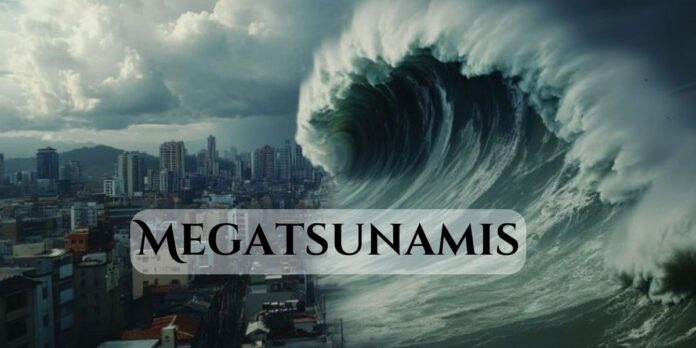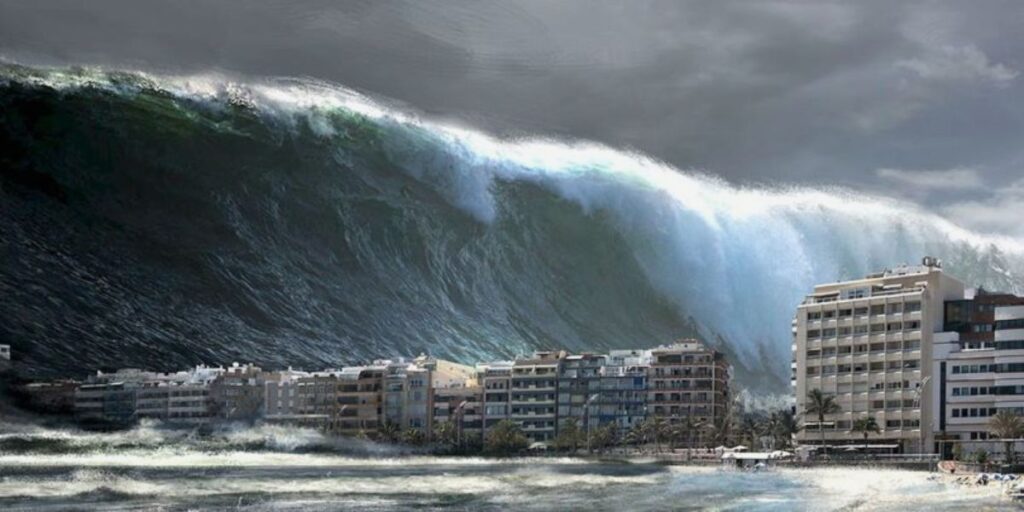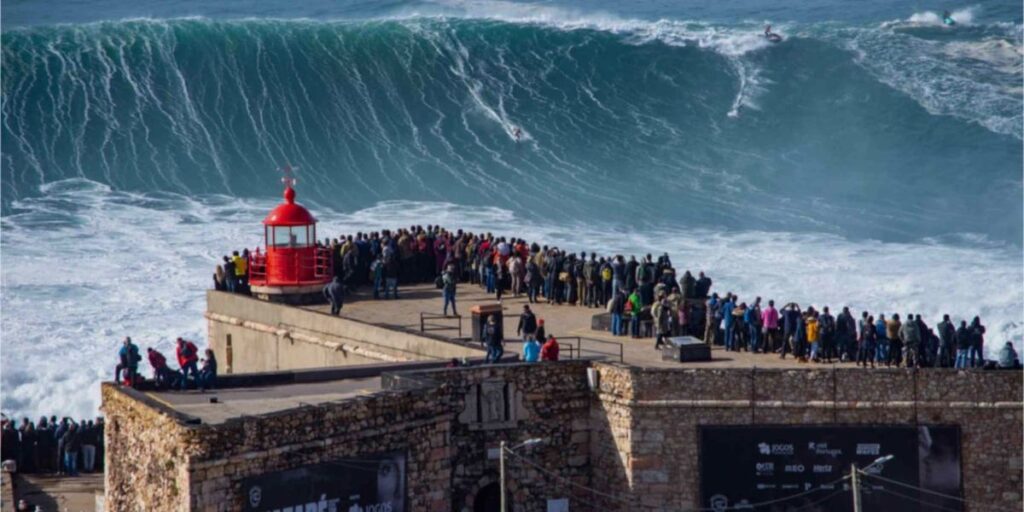A megatsunami is a colossal natural phenomenon characterized by massive waves that can rise hundreds of meters above sea level, dwarfing regular tsunamis in both height and destructive force. These extraordinary waves are rare and triggered by large-scale geological events, such as landslides, volcanic eruptions, or even asteroid impacts. While regular tsunamis are typically caused by undersea earthquakes, megatsunamis have a much different origin. Making them unique in their size and the level of destruction they can unleash.
What Causes a Megatsunami?
Unlike typical tsunamis, which form when the ocean floor shifts during an earthquake, megatsunamis are generated by the sudden displacement of enormous volumes of water due to a different set of forces. The primary causes include:
- Landslides: When a massive amount of rock and earth from a mountain or cliff plunges into a body of water. It can displace a significant amount of water, causing a megatsunami. This type of event typically occurs in regions with high seismic activity or unstable volcanic regions.
- Volcanic Eruptions: Some megatsunamis are linked to volcanic eruptions, particularly when large chunks of a volcanic island collapse into the sea, rapidly displacing water. This was the case with the 1883 eruption of Krakatoa, which triggered a deadly tsunami, though not technically a megatsunami in scale.
- Asteroid Impacts: While extremely rare, the impact of an asteroid or comet into an ocean could displace enough water to trigger a megatsunami. This type of event is hypothesized to have occurred during the Cretaceous–Paleogene extinction event, when a massive asteroid struck Earth, causing significant climatic and ecological changes.
- Glacial Events: Megatsunamis can also be caused by the collapse of massive glaciers into the ocean, particularly in regions where climate change is accelerating the melting of ice sheets. The displacement of icebergs and melting ice creates enough force to trigger these monumental waves.
Famous Megatsunami Events in History
While megatsunamis are infrequent, there have been several documented and hypothesized events throughout history.
- Lituya Bay, Alaska (1958): Perhaps the most famous modern example of a megatsunami occurred in Lituya Bay. A magnitude 7.8 earthquake triggered a massive landslide, displacing approximately 30 million cubic meters of rock into the narrow bay. The resulting wave reached an astonishing height of 524 meters (1,719 feet), devastating the surrounding forest. Miraculously, despite the immense force of the wave, only a few lives were lost.
- Storegga Slides (Norwegian Sea, 8,000 years ago): The Storegga Slides were a series of massive underwater landslides off the coast of Norway. Which caused a megatsunami that is believed to have devastated coastal regions around the North Atlantic. It is hypothesized that this event contributed to the flooding of the Doggerland, a landmass that once connected Great Britain to mainland Europe.
- Tsunami Linked to Santorini Volcano (Late Bronze Age): Another event speculated to be a megatsunami occurred around 1600 BCE when the Santorini volcanic island in the Mediterranean erupted catastrophically. This eruption led to the collapse of part of the island into the sea. Which may have caused a massive wave that affected nearby civilizations, including the Minoan civilization on Crete.
Potential Future Megatsunami Threats
While megatsunamis are rare, the potential for future events still exists. There are several known sites around the world where conditions are ripe for a catastrophic event:
- La Palma, Canary Islands: One of the most concerning scenarios for scientists is the potential collapse of the Cumbre Vieja volcano on the island of La Palma. Studies suggest that if a significant portion of the volcano’s western flank were to collapse into the Atlantic Ocean. It could trigger a massive megatsunami that could affect coastlines across the Atlantic, including the United States, Europe, and Africa.
- Glacial Melting in Greenland and Antarctica: As climate change accelerates. The melting of glaciers and ice sheets in Greenland and Antarctica could increase the risk of megatsunamis. The collapse of large ice masses into the ocean could displace enormous volumes of water, potentially causing waves to devastate coastal communities around the globe.
The Science of Megatsunamis: How They Differ from Regular Tsunamis
One of the main differences between a megatsunami and a regular tsunami is the height and reach of the wave. Regular tsunamis, caused by undersea earthquakes, typically have waves that are only a few meters high but can travel great distances across oceans, causing widespread flooding. In contrast, a megatsunami can reach hundreds of meters in height but tends to be more localized. Impacting a more specific area with overwhelming force.
The speed and energy released by megatsunamis are also on a different scale. A regular tsunami might travel at speeds of 500 to 800 km/h across the ocean. But a megatsunami, being closer to its point of origin, strikes with much greater intensity, with minimal time for evacuation or preparation. Their towering waves can sweep away forests, buildings, and anything else in their path, leaving a trail of devastation.
Preparing for Megatsunami Risk
Though megatsunamis are exceedingly rare, their catastrophic potential means that scientists are working to identify areas at risk and to develop early warning systems. Studying the geological features of coastal regions and monitoring seismic activity are essential for understanding potential triggers for future events. Monitoring volcanic islands, unstable mountain ranges, and glacial areas is critical to preventing disaster.
One challenge in megatsunami preparation is their unpredictability. Unlike tsunamis, often preceded by seismic activity or measurable undersea disturbances. The events that trigger megatsunamis, such as landslides or volcanic collapses, can happen without warning. Therefore, disaster preparedness plans in vulnerable areas. Particularly in the Canary Islands, Alaska, and Greenland, are crucial to minimizing loss of life and property damage.
Conclusion
A megatsunami is a rare but awe-inspiring natural event, capable of immense destruction. Historical records show that such waves have impacted parts of the world in the past. Modern science is better equipped than ever to study, monitor, and potentially mitigate future risks. While the prospect of a megatsunami may seem distant. Its catastrophic potential makes it a topic of serious study and planning for scientists, governments, and coastal communities worldwide.




